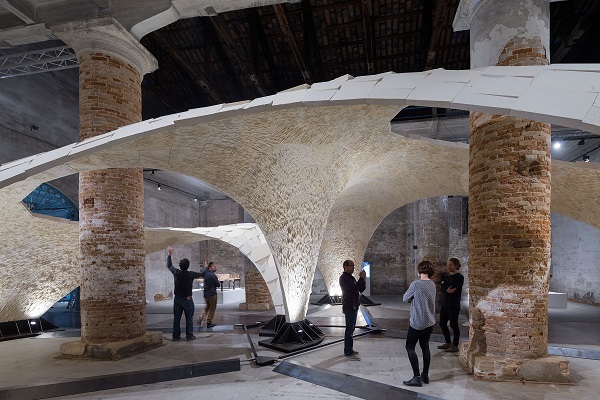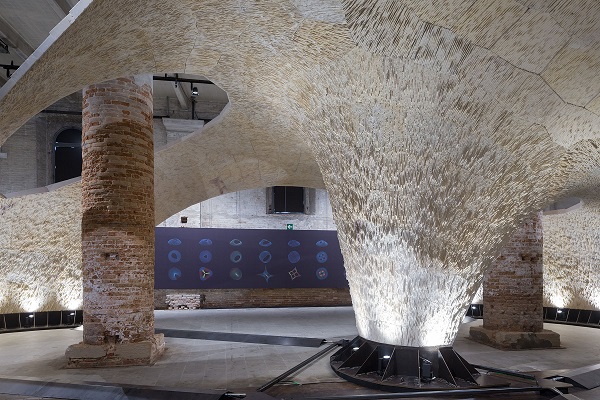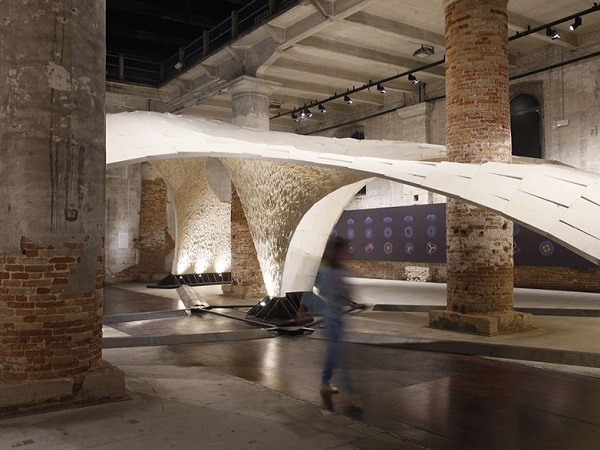Beyond bending - The Armadillo Vault
Throughout June 2016, the 'Beyond Bending' installation is being showcased at the15th International Architecture Exhibition in Venice. The installation demonstrates the Armadillo Vault, an innovative limestone canopy that uses no adhesive and has been called a "milestone for stone engineering".
Inspired by historical design and construction methods, ETH Zurich’s Block Research Group, led by Prof. Dr. Philippe Block and Dr. Tom Van Mele, renew the knowledge of the past using present-day technologies to discover elegant new structural forms.
Beyond Bending is a collaborative effort with the engineering firm Ochsendorf, DeJong & Block (ODB) and The Escobedo Group, and aims to offer answers to the question, 'What can we regain from the past, and how can we reshape or innovate upon that knowledge to fit present and future needs?'
The exhibition’s various elements – four prototypes of vaulted floor systems, a series of graphical force diagrams, and an expansive stone vault – demonstrate that, by better understanding the flow of compressive forces in three dimensions, excess steel can be eliminated, natural resources can be conserved, and materials like earth and stone can be reimagined for the future.
The exhibition’s centrepiece, the Armadillo Vault, embodies compression made possible through geometry. Its shape comes from the same structural and constructional principles as historic stone cathedrals, enhanced and extended by computation and digital fabrication.
Comprised of 399 individually-cut stones, unreinforced and without mortar, the vault spans 16 m with a minimum thickness of only 5 cm. The tension ties balance the form, and funicular geometry allows the vault to stand in pure compression.
The sophisticated form of the Armadillo Vault emerged from computational graphic-statics based design and optimisation methods developed by the Block Research Group. The engineering of the geometrically discrete shell, done by ODB Engineering, also used innovative computational approaches to assess stability.
Each stone is informed by structural logic, by the need for precise fabrication and assembly, by the hard constraints of a historically protected setting in the Biennale’s Corderie dell'Arsenale, as well as by tight limitations on time, budget, and construction. To simplify the fabrication process and avoid the need to flip the stones during cutting, the limestone wedges are planar and smooth on the exterior. Their interior sides are marked by a series of grooves resulting from initial rough cutting. Rather than mill these surfaces away, they remain as an expressive feature, aligned with purpose to serve as visual reminders of the force flow.
After its initial fabrication and assembly by The Escobedo Group in Texas, the vault was carefully measured and marked, disassembled and shipped to Venice, where the same team of master stonemasons reassembled it on site in just over two weeks. Like an intricate 3D puzzle, it could be deconstructed and built again at future locations.
This unique project grows out of a foundation of trust and experience gained individually and collectively and is the culmination of many years of research in all aspects of stone structures by the team members.
Content and images courtesy of ETH Zurich.
“Beyond Bending”
Main exhibition, Corderie dell’Arsenale – Block Research Group
15th International Architecture Exhibition in Venice
[edit] Related articles on Designing Buildings
Featured articles and news
Key points for construction at a glance with industry reactions.
Functionality, visibility and sustainability
The simpler approach to specification.
Architects, architecture, buildings, and inspiration in film
The close ties between makers and the movies, with our long list of suggested viewing.
SELECT three-point plan for action issued to MSPs
Call for Scottish regulation, green skills and recognition of electrotechnical industry as part of a manifesto for Scottish Parliamentary elections.
UCEM becomes the University of the Built Environment
Major milestone in its 106-year history, follows recent merger with London School of Architecture (LSE).
Professional practical experience for Architects in training
The long process to transform the nature of education and professional practical experience in the Architecture profession following recent reports.
A people-first approach to retrofit
Moving away from the destructive paradigm of fabric-first.
International Electrician Day, 10 June 2025
Celebrating the role of electrical engineers from André-Marie Amperè, today and for the future.
New guide for clients launched at Houses of Parliament
'There has never been a more important time for clients to step up and ...ask the right questions'
The impact of recycled slate tiles
Innovation across the decades.
EPC changes for existing buildings
Changes and their context as the new RdSAP methodology comes into use from 15 June.
Skills England publishes Sector skills needs assessments
Priority areas relating to the built environment highlighted and described in brief.
BSRIA HVAC Market Watch - May 2025 Edition
Heat Pump Market Outlook: Policy, Performance & Refrigerant Trends for 2025–2028.
Committing to EDI in construction with CIOB
Built Environment professional bodies deepen commitment to EDI with two new signatories: CIAT and CICES.
Government Grenfell progress report at a glance
Line by line recomendation overview, with links to more details.
An engaging and lively review of his professional life.
Sustainable heating for listed buildings
A problem that needs to be approached intelligently.
50th Golden anniversary ECA Edmundson apprentice award
Deadline for entries has been extended to Friday 27 June, so don't miss out!
CIAT at the London Festival of Architecture
Designing for Everyone: Breaking Barriers in Inclusive Architecture.
Mixed reactions to apprenticeship and skills reform 2025
A 'welcome shift' for some and a 'backwards step' for others.





























